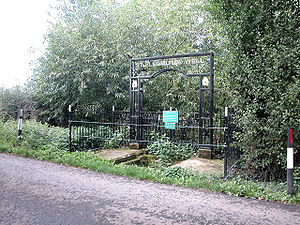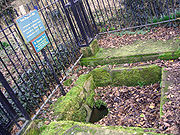
St. Plegmund's well
Encyclopedia

St Peter's Church, Plemstall
St Peter's Church, Plemstall stands in an isolated position at the end of a country lane near the village of Mickle Trafford, Cheshire, England. It has been designated by English Heritage as a Grade I listed building. It is an active Anglican parish church in the diocese of Chester, the...
near the village of Mickle Trafford
Mickle Trafford
Mickle Trafford is a village and civil parish in the unitary authority of Cheshire West and Chester and the ceremonial county of Cheshire, England. It includes the area known as Plemstall. In 2004 the population of the civil parish was estimated to be 2,140, although the 2001 census recorded...
, Cheshire
Cheshire
Cheshire is a ceremonial county in North West England. Cheshire's county town is the city of Chester, although its largest town is Warrington. Other major towns include Widnes, Congleton, Crewe, Ellesmere Port, Runcorn, Macclesfield, Winsford, Northwich, and Wilmslow...
, England . It is named after Plegmund
Plegmund
Plegmund , after spending time as a hermit, became Archbishop of Canterbury in England from 890 to 914. He reorganised the Diocese of Winchester, creating four new sees, and worked with other scholars in translating religious works...
, who later became Archbishop of Canterbury
Archbishop of Canterbury
The Archbishop of Canterbury is the senior bishop and principal leader of the Church of England, the symbolic head of the worldwide Anglican Communion, and the diocesan bishop of the Diocese of Canterbury. In his role as head of the Anglican Communion, the archbishop leads the third largest group...
, and who is believed to have lived as a hermit nearby. The well is situated on the edge of a low cliff to the east of which is one of the channels of the River Gowy
River Gowy
The River Gowy is a river in Cheshire, England and a tributary of the River Mersey.It rises in western Cheshire in the hills near Peckforton Castle, very close to the source of the River Weaver. While the Weaver flows south initially, the Gowy flows north and for several miles provides the valley...
. It is one of two holy well
Holy well
A holy well, or sacred spring, is a small body of water emerging from underground and revered either in a Pagan or Christian context, often both. Holy wells were frequently pagan sacred sites that later became Christianized. The term 'holy well' is commonly employed to refer to any water source of...
s in west Cheshire. An inscribed sandstone
Sandstone
Sandstone is a sedimentary rock composed mainly of sand-sized minerals or rock grains.Most sandstone is composed of quartz and/or feldspar because these are the most common minerals in the Earth's crust. Like sand, sandstone may be any colour, but the most common colours are tan, brown, yellow,...
curb was added in 1907 which was dedicated by the Venerable E. Barber, Archdeacon of Chester, on 11 November 1907. The earliest documentary evidence of the well is in a quitclaim
Quitclaim deed
A quitclaim deed is a legal instrument by which the owner of a piece of real property, called the grantor, transfers his interest to a recipient, called the grantee. The owner/grantor terminates his right and claim to the property, thereby allowing claim to transfer to the...
dated 1301.
A survey of the well was carried out in 1995 which found that it is a square stone-lined pit with two large slabs on either side and two steps down from the southern side beside the road. In the bottom of the well is a ceramic
Ceramic
A ceramic is an inorganic, nonmetallic solid prepared by the action of heat and subsequent cooling. Ceramic materials may have a crystalline or partly crystalline structure, or may be amorphous...
pipe which has been inserted at a later date. At the time of the survey there was water present up to the level of the first step. The cover slabs show some signs of damage but there was no sign of the curbs added in 1907.


